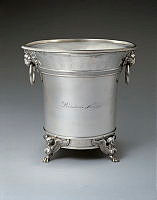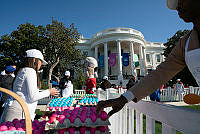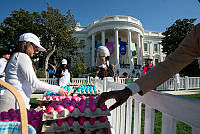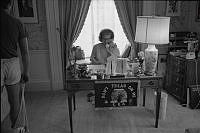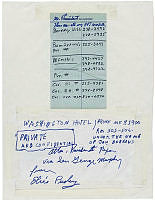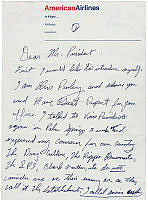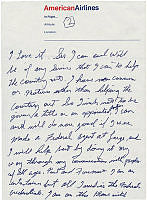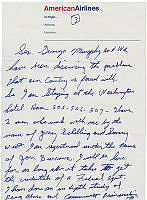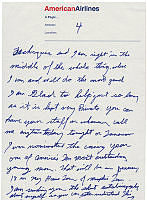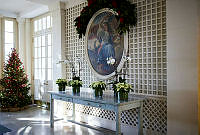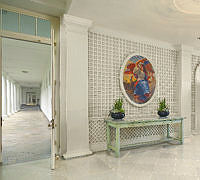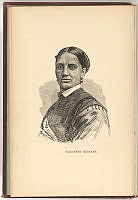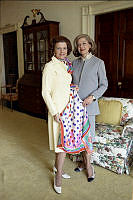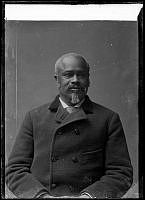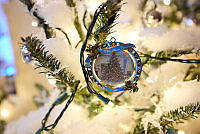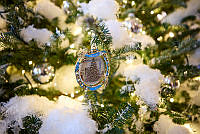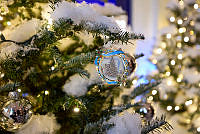Rubenstein Center Scholarship
White House Workers Timeline
1790s - 2000s
The White House Historical Association has undertaken a research initiative called "Slavery in the President's Neighborhood." With this initiative, the Association seeks to tell the stories of the enslaved and free African Americans who built, lived, and worked at the White House, as well as the surrounding homes on Lafayette Park. While there are few written accounts of their experiences, their voices can be found in letters, newspapers, memoirs, census records, architecture, and oral histories. By connecting these details from diverse sources, the White House Historical Association seeks to return these individuals to the historical forefront, intertwining their stories with the lives of the presidents, first ladies, and first families.
When John and Abigail Adams became the first residents of the unfinished White House, which in 1800 had six habitable rooms, they brought only four servants with them. Currently, the 132-room Executive Mansion requires approximately 90 employees to complete myriad daily tasks.
1790s:
President John Adams moved into the White House on November 1, 1800. He brought John Briesler, the Adamses’ longtime steward, a few white male servants, and several white lady’s maids. They may have hired additional free or enslaved African-American workers. Read More.
1800s:
Thomas Jefferson brought three enslaved women—Ursula Granger Hughes, Edith Fossett, and Frances Hern—to the White House to serve as cooks. For the rest of the White House staff, he preferred white hired servants that could be dismissed for misconduct. Read More.
1810s:
During the Madisons’s residence in the White House, they primarily relied on enslaved people that they brought from their plantation, Montpelier, including Paul Jennings, Sukey, Joseph Bolden, Jim, and Abram. Read More.
1820s:
Both James Monroe and John Quincy Adams relied on a mix of white workers and enslaved laborers. Monroe brought enslaved individuals that he owned from his properties in Virginia. Adams’s household was run by Antoine Michel Guista, his valet since they met in Belgium in 1814. Two enslaved individuals, Holzey and Rachel Clark, who were owned by Adams’s niece and nephew, accompanied the Adamses to the White House. Read More.
1830s:
President Andrew Jackson brought numerous enslaved people with him from Tennessee to the President’s House. His successor, Martin Van Buren, also relied on enslaved labor, as well as free African Americans and white workers in the Executive Mansion. Read more about the enslaved households of Jackson and Van Buren.
1840s:
John Tyler brought enslaved people to the White House and employed both free African Americans and white staff members. The Polks staffed the White House with enslaved labor that they brought from their home in Nashville, Tennessee, and hired out enslaved labor in Washington. James K. Polk also bought an additional thirteen enslaved children during his presidency. Read more about the enslaved households of Tyler and Polk.
1850s:
By the end of the 1850s, much of the White House staff was replaced with foreign laborers. James Buchanan preferred white, European domestics over African Americans and white American workers. Read More.
1860s:
President Abraham Lincoln hired a mix of white and free African-American servants, many of whom had previously been held in bondage, including seamstresses Rosetta Wells and Mrs. John Brooks, and dining room manager Peter Brown. Read More.
1870s:
The frigate United States left Port Mahone, Minorca, arriving in New York City on December 25, 1834. On board was an orphan boy about seven years of age, Valentino Melah, a native of Messina, Sicily. Read More.
1880s:
Thomas F. Pendel was a White House doorman from the Abraham Lincoln administration to the turn of the 20th century. By the time Chester A. Arthur succeeded James A. Garfield in September 1881, Pendel had experienced the assassinations of both Lincoln and Garfield. Read more.
1890s:
Ike Hoover spent 42 years working at the White House, advancing from electrician into the ushers' ranks. During the Taft administration he was appointed Chief Usher, and he held this job until he died in 1933. Read More.
1900s:
Elizabeth Jaffray joined the White House staff in 1909 under the Tafts. Hiring Mrs. Jaffray represented a major change in White House management: substituting a female housekeeper for a male steward. Read More.
1910s:
White House staff in the Woodrow Wilson administration experienced both the death of Wilson's first wife, Ellen Axson Wilson, on August 6, 1914; and Wilson's second marriage, sixteen months later. Read More.
1920s:
Maggie Rogers, who served as Grace Coolidge's maid, regularly ensured that the First Lady's costume was in order before the Coolidges greeted their guests. Read More.
1930s:
Prior to the 1939 visit of the queen and king of England, Eleanor Roosevelt received a State Department memorandum, listing various rules of protocol. Mrs. Roosevelt became concerned about the order in which the Roosevelts, and the queen and king, should be served at the state dinner honoring the royal couple. Read More.
1940s:
After the United States entered World War II, British Prime Minister Winston Churchill was a frequent guest in the Roosevelt White House. Read More.
1950s:
Largely through television, notes historian William Seale, the White House "is the best known house in the world, the instantly familiar symbol of the Presidency, flashed daily on millions and millions of TV screens everywhere." Read More.
1960s:
President and Mrs. John F. Kennedy had developed a bond with White House doorman Preston Bruce. The slain President's brother, Attorney General Robert Kennedy, invited Bruce to walk with members of the Kennedy family to JFK's memorial service at St. Matthew's Cathedral. Read More.
1970s:
In March 1971, President Richard M. Nixon announced the engagement of his daughter Patricia to Edward Cox. The details of the wedding preparations soon appeared in newspapers. Read More.
1980s:
A reunion picnic on June 24, 1983, was the scene of hugging, kissing, and backslapping, as former White House domestic staff greeted one another with laughter, emotion, and plenty of memories. Read More.
1990s:
Coinciding with the 200th anniversary of the White House, the Festival of American Folklife featured a program entitled "Workers at the White House" on the National Mall in Washington, D.C. Read More.







